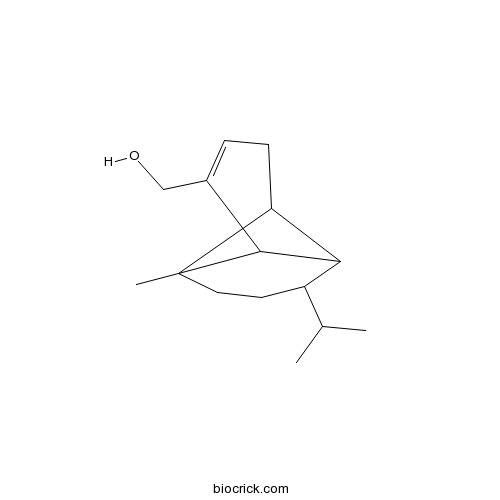YlangenolCAS# 41610-69-9 |

Quality Control & MSDS
3D structure
Package In Stock
Number of papers citing our products

| Cas No. | 41610-69-9 | SDF | Download SDF |
| PubChem ID | 179519 | Appearance | Oil |
| Formula | C15H24O | M.Wt | 220.35 |
| Type of Compound | Sesquiterpenoids | Storage | Desiccate at -20°C |
| Solubility | Soluble in Chloroform,Dichloromethane,Ethyl Acetate,DMSO,Acetone,etc. | ||
| SMILES | CC(C)C1CCC2(C3C1C2C(=CC3)CO)C | ||
| Standard InChIKey | JIXPRNKLOIEGFI-UHFFFAOYSA-N | ||
| Standard InChI | InChI=1S/C15H24O/c1-9(2)11-6-7-15(3)12-5-4-10(8-16)14(15)13(11)12/h4,9,11-14,16H,5-8H2,1-3H3 | ||
| General tips | For obtaining a higher solubility , please warm the tube at 37 ℃ and shake it in the ultrasonic bath for a while.Stock solution can be stored below -20℃ for several months. We recommend that you prepare and use the solution on the same day. However, if the test schedule requires, the stock solutions can be prepared in advance, and the stock solution must be sealed and stored below -20℃. In general, the stock solution can be kept for several months. Before use, we recommend that you leave the vial at room temperature for at least an hour before opening it. |
||
| About Packaging | 1. The packaging of the product may be reversed during transportation, cause the high purity compounds to adhere to the neck or cap of the vial.Take the vail out of its packaging and shake gently until the compounds fall to the bottom of the vial. 2. For liquid products, please centrifuge at 500xg to gather the liquid to the bottom of the vial. 3. Try to avoid loss or contamination during the experiment. |
||
| Shipping Condition | Packaging according to customer requirements(5mg, 10mg, 20mg and more). Ship via FedEx, DHL, UPS, EMS or other couriers with RT, or blue ice upon request. | ||
| Description | Standard reference |
| Structure Identification | Chem Biodivers. 2014 Sep;11(9):1398-405.Fragrant volatile sesquiterpenoids isolated from the essential oil of Laggera pterodonta by using olfactory-guided fractionation.[Pubmed: 25238080 ]
|

Ylangenol Dilution Calculator

Ylangenol Molarity Calculator
| 1 mg | 5 mg | 10 mg | 20 mg | 25 mg | |
| 1 mM | 4.5382 mL | 22.6912 mL | 45.3823 mL | 90.7647 mL | 113.4559 mL |
| 5 mM | 0.9076 mL | 4.5382 mL | 9.0765 mL | 18.1529 mL | 22.6912 mL |
| 10 mM | 0.4538 mL | 2.2691 mL | 4.5382 mL | 9.0765 mL | 11.3456 mL |
| 50 mM | 0.0908 mL | 0.4538 mL | 0.9076 mL | 1.8153 mL | 2.2691 mL |
| 100 mM | 0.0454 mL | 0.2269 mL | 0.4538 mL | 0.9076 mL | 1.1346 mL |
| * Note: If you are in the process of experiment, it's necessary to make the dilution ratios of the samples. The dilution data above is only for reference. Normally, it's can get a better solubility within lower of Concentrations. | |||||

Calcutta University

University of Minnesota

University of Maryland School of Medicine

University of Illinois at Chicago

The Ohio State University

University of Zurich

Harvard University

Colorado State University

Auburn University

Yale University

Worcester Polytechnic Institute

Washington State University

Stanford University

University of Leipzig

Universidade da Beira Interior

The Institute of Cancer Research

Heidelberg University

University of Amsterdam

University of Auckland

TsingHua University

The University of Michigan

Miami University

DRURY University

Jilin University

Fudan University

Wuhan University

Sun Yat-sen University

Universite de Paris

Deemed University

Auckland University

The University of Tokyo

Korea University
- (-)-Pinoresinol 4-O-glucoside
Catalog No.:BCN7251
CAS No.:41607-20-9
- 4,R-ajmalicine N-oxide
Catalog No.:BCN5473
CAS No.:41590-29-8
- Carboplatin
Catalog No.:BCC1170
CAS No.:41575-94-4
- Poricoic acid G
Catalog No.:BCN8267
CAS No.:415724-84-4
- RI-1
Catalog No.:BCC1896
CAS No.:415713-60-9
- SN-6
Catalog No.:BCC7273
CAS No.:415697-08-4
- N6-Cyclopentyladenosine
Catalog No.:BCC7160
CAS No.:41552-82-3
- 1-(3,4-dimethoxyphenyl)-2-(4-allly-2,6-dimethoxyphenoxy)propan-1-ol
Catalog No.:BCN1445
CAS No.:41535-95-9
- 2,6,16-Kauranetriol
Catalog No.:BCN5472
CAS No.:41530-90-9
- Koaburaside monomethyl ether
Catalog No.:BCN5471
CAS No.:41514-64-1
- Daturaolone
Catalog No.:BCN3904
CAS No.:41498-80-0
- 12-Oleanene-3,6-diol
Catalog No.:BCN3903
CAS No.:41498-79-7
- Ciclopirox ethanolamine
Catalog No.:BCC4372
CAS No.:41621-49-2
- Lacinilene C
Catalog No.:BCN5474
CAS No.:41653-72-9
- Koaburaside
Catalog No.:BCN5475
CAS No.:41653-73-0
- 7-O-Methyl morroniside
Catalog No.:BCN3882
CAS No.:41679-97-4
- Catharanthine hemitartrate
Catalog No.:BCN8463
CAS No.:4168-17-6
- 2H-1-Benzopyran-7-yloxy
Catalog No.:BCN3580
CAS No.:41680-08-4
- 4',7-Dihydroxyflavanone
Catalog No.:BCC8333
CAS No.:41680-09-5
- 8-Methyleugenitol
Catalog No.:BCN6459
CAS No.:41682-21-7
- Arctigenin 4'-O-beta-gentiobioside
Catalog No.:BCN2847
CAS No.:41682-24-0
- 8-Acetoxypentadeca-1,9Z-diene-4,6-diyn-3-ol
Catalog No.:BCN1444
CAS No.:41682-30-8
- Epiaschantin
Catalog No.:BCN7206
CAS No.:41689-50-3
- Epimagnolin A
Catalog No.:BCN7831
CAS No.:41689-51-4
Fragrant volatile sesquiterpenoids isolated from the essential oil of Laggera pterodonta by using olfactory-guided fractionation.[Pubmed:25238080]
Chem Biodivers. 2014 Sep;11(9):1398-405.
Chemical composition of the essential oil from Laggera pterodonta (Compositae) was inverstigated. GC/MS Analyses led to the identification of 68 components, representing more than 96% of the total oil. By focusing on the woody note fraction of the essential oil, one new bisabolane-type sesquiterpenoid, bisabola-2,7(14),11-trien-10-ol (1), together with ten known compounds, bisabolol oxide B (2), Ylangenol (3), copaborneol (4), guai-11-en-10-ol (5), spathulenol (6), aromadendran-10-ol (7), caryophyllenol (8), 5alpha,7alpha-eudesm-11(13)-en-4alpha-ol (9), gamma-costic acid (10), and eudesma-4(15),11(13)-diene-12,5beta-olide (11), were isolated by using olfactory-guided fractionation. The structures of the eleven compounds were determined by NMR and MS analyses. All the volatile compounds reported here were isolated for the first time from this plant. On the basis of preliminary odor assessment, the odor of the woody-note fractions of the essential oil was assumed to be due to these isolated sesquiterpenoids.


